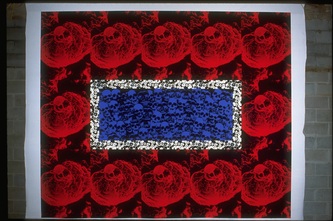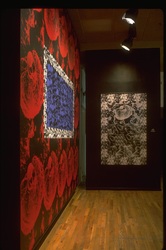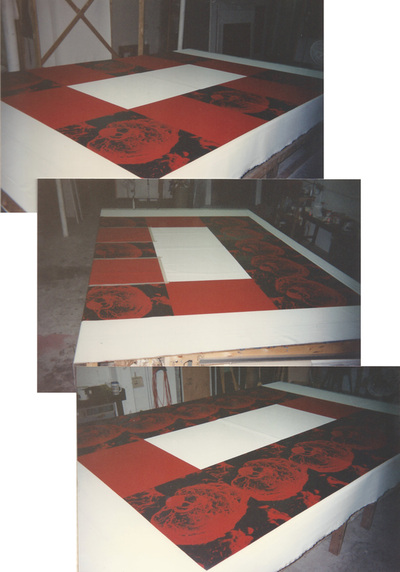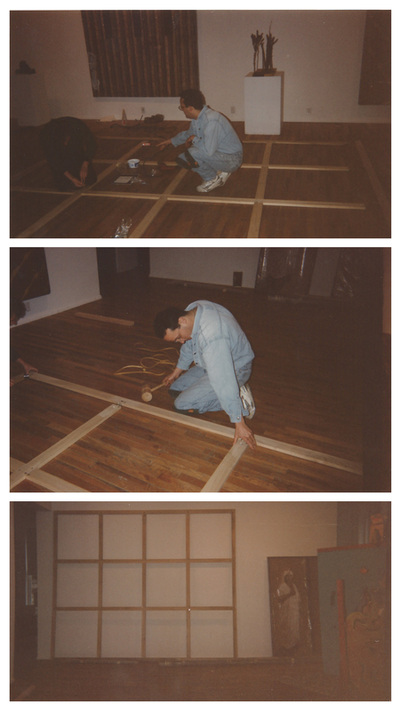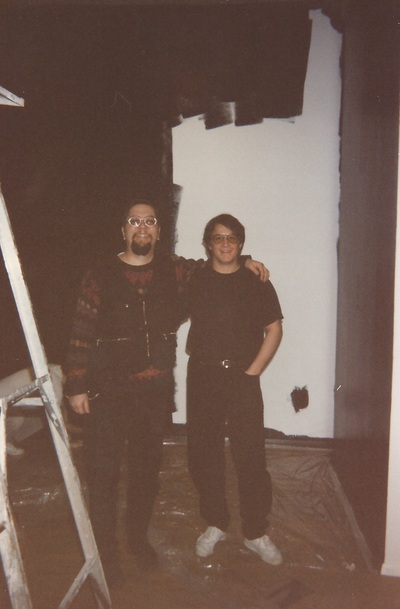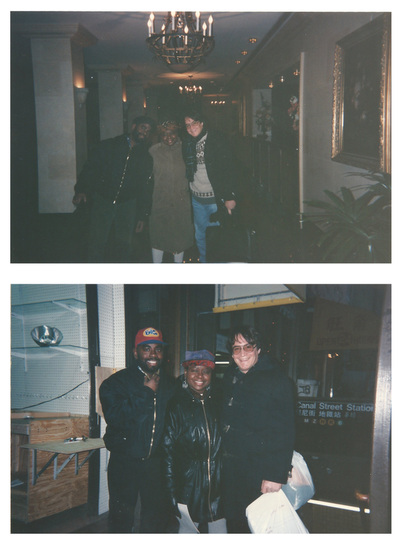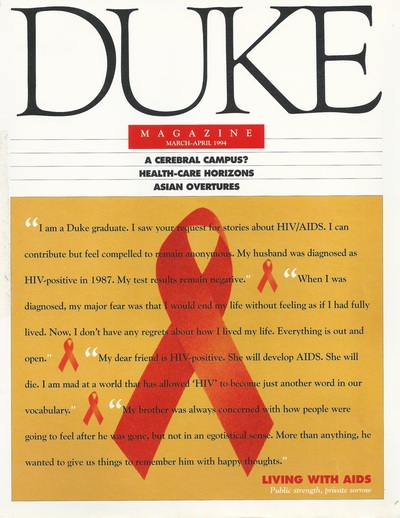AIDS Forum
Featured Artist: Carl Tandatnick
Artists Space January 1994
click on images to enlarge
Artists
Space - AIDS Forum Carl Tandatnick January 1994
Press Release
The USAIDS painting is 1Oft. x 12ft. in the medium of photo silkscreen on canvas. The RED outer band shows repeated images of the actual AIDS virus attacking white blood cells magnified many thousands of times by an electron microscope. The small WHITE band shows non-infected white and red blood cells under less magnification. The BLUE center shows an array of skulls symbolic of the past, present, and future tragedy of this terrible plague.
The photographic collage entitled AIDS PYRAMID is 5ft. x 3 ft. 6in. and shows images of non-infected white and red blood cells under various magnifications culminating at the top with the AIDS virus attacking a white blood cell.
The AIDS epidemic continues to rage across our planet. This plague is a defining marker for the late 20th and 21st first century. It has been scarcely 13 years since die first symptoms of AIDS were reported. It has been only 10 years since the virus was identified. In that time period close to 400,000 individuals in the USA have died from AIDS. About 200 people become infected with the AIDS virus in the USA everyday. In 1994 535,000 Americans will be HIV positive. Worldwide estimates are that 14 million people have already perished from this disease. It is projected that 40 million people will be HIV positive by the year 2000. At the present time there is no cure for AIDS.
All body fluids may potentially transmit the virus. Protect yourself and others. For more information about HIV/AIDS, please call: National AIDS Hotline Centers for Disease Control at the following numbers:
1-800-342-AIDS
1-800-344-7432 (Spanish)
1 -800-243-7889 (TDD/Deaf Access)
Or write to the American Association for World Health:
1120 20th Street N.W. Suite 400,
Washington, DC 20036-3403
If you would like information about AIDS-related or other volunteer opportunities, call your local Volunteer Center or The Points of Light Foundation at:
1-800-468-7686
Through education and research, compassion and unity in our fight against this disease we can prevail.
Press Release
The USAIDS painting is 1Oft. x 12ft. in the medium of photo silkscreen on canvas. The RED outer band shows repeated images of the actual AIDS virus attacking white blood cells magnified many thousands of times by an electron microscope. The small WHITE band shows non-infected white and red blood cells under less magnification. The BLUE center shows an array of skulls symbolic of the past, present, and future tragedy of this terrible plague.
The photographic collage entitled AIDS PYRAMID is 5ft. x 3 ft. 6in. and shows images of non-infected white and red blood cells under various magnifications culminating at the top with the AIDS virus attacking a white blood cell.
The AIDS epidemic continues to rage across our planet. This plague is a defining marker for the late 20th and 21st first century. It has been scarcely 13 years since die first symptoms of AIDS were reported. It has been only 10 years since the virus was identified. In that time period close to 400,000 individuals in the USA have died from AIDS. About 200 people become infected with the AIDS virus in the USA everyday. In 1994 535,000 Americans will be HIV positive. Worldwide estimates are that 14 million people have already perished from this disease. It is projected that 40 million people will be HIV positive by the year 2000. At the present time there is no cure for AIDS.
All body fluids may potentially transmit the virus. Protect yourself and others. For more information about HIV/AIDS, please call: National AIDS Hotline Centers for Disease Control at the following numbers:
1-800-342-AIDS
1-800-344-7432 (Spanish)
1 -800-243-7889 (TDD/Deaf Access)
Or write to the American Association for World Health:
1120 20th Street N.W. Suite 400,
Washington, DC 20036-3403
If you would like information about AIDS-related or other volunteer opportunities, call your local Volunteer Center or The Points of Light Foundation at:
1-800-468-7686
Through education and research, compassion and unity in our fight against this disease we can prevail.
Click on images to enlarge
AIDS Forum Press
Art By Science Downtown Express
Artists and scientists may not hang out in the same clubs—they don't even use the same side of the brain. In Carl Tandatnick's paintings, however, the two schools not only meet, they merge.
Tandatnick's works celebrate what he calls the "beauty of that microscopic world" through the medium of photo-silk screen on canvas.
"The human body can be both beautiful and terrible," says Tandatnick. "It's various complexities are art." Indeed, one of his most compelling and fully-realized works is titled AIDS Virus Attacking White Blood Cells.
"As art approaches a new millennium," Tandatnick says, "our interaction with science will shape and expand our visual horizon as a new world of images is revealed."
His paintings will be on display at the Alternative Museum National Showcase at 594 Broadway, suite 402, through Aug. 14, and with the Artist Space, at 233 West Broadway, in the AIDS Forum.
Both Beautiful And Terrible Duke Magazine
At first glance, these silk-screened color images are magnificent in an ambiguous, abstract way. A closer look reveals something familiar: blood cells. Some are sturdy, rounded and whole. Others look damaged, the normally smooth surfaces rough and ragged. As viewers come to realize what they're viewing-healthy cells and ceils under attack by HIV-the work takes on an added dimension.
"The human body can be both beautiful and terrible," says artist and anesthesiologist Carl Tandatnick, who uses electron micrographs of blood cells magnified 2,000 to 4,000 times. "As art approaches the new millennium, our interaction with science will shape and expand our visual horizons."
At the beginning of this year, Tandatnick's "USAIDS," a ten-by-twelve foot photo silkscreen installation, was exhibited at New York City's Artists Space AIDS Forum. His work has also been shown at the San Diego Art Institute and New York's Foster Peet Gallery. Such public presentations, says Tandatnick, are important steps in bringing scientific irrefutability of AIDS-there are no "lifestyle choices” at the microscopic level-to people's attention.
"As a world of new images is revealed, our pleasure and responsibility as artists of the twenty first century is to draw upon them and make them available to a wider audience through our art."
Art By Science Downtown Express
Artists and scientists may not hang out in the same clubs—they don't even use the same side of the brain. In Carl Tandatnick's paintings, however, the two schools not only meet, they merge.
Tandatnick's works celebrate what he calls the "beauty of that microscopic world" through the medium of photo-silk screen on canvas.
"The human body can be both beautiful and terrible," says Tandatnick. "It's various complexities are art." Indeed, one of his most compelling and fully-realized works is titled AIDS Virus Attacking White Blood Cells.
"As art approaches a new millennium," Tandatnick says, "our interaction with science will shape and expand our visual horizon as a new world of images is revealed."
His paintings will be on display at the Alternative Museum National Showcase at 594 Broadway, suite 402, through Aug. 14, and with the Artist Space, at 233 West Broadway, in the AIDS Forum.
Both Beautiful And Terrible Duke Magazine
At first glance, these silk-screened color images are magnificent in an ambiguous, abstract way. A closer look reveals something familiar: blood cells. Some are sturdy, rounded and whole. Others look damaged, the normally smooth surfaces rough and ragged. As viewers come to realize what they're viewing-healthy cells and ceils under attack by HIV-the work takes on an added dimension.
"The human body can be both beautiful and terrible," says artist and anesthesiologist Carl Tandatnick, who uses electron micrographs of blood cells magnified 2,000 to 4,000 times. "As art approaches the new millennium, our interaction with science will shape and expand our visual horizons."
At the beginning of this year, Tandatnick's "USAIDS," a ten-by-twelve foot photo silkscreen installation, was exhibited at New York City's Artists Space AIDS Forum. His work has also been shown at the San Diego Art Institute and New York's Foster Peet Gallery. Such public presentations, says Tandatnick, are important steps in bringing scientific irrefutability of AIDS-there are no "lifestyle choices” at the microscopic level-to people's attention.
"As a world of new images is revealed, our pleasure and responsibility as artists of the twenty first century is to draw upon them and make them available to a wider audience through our art."
